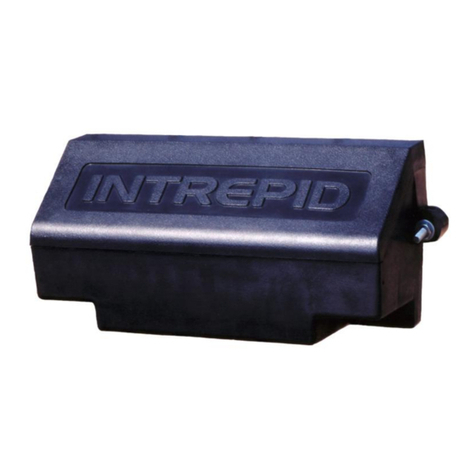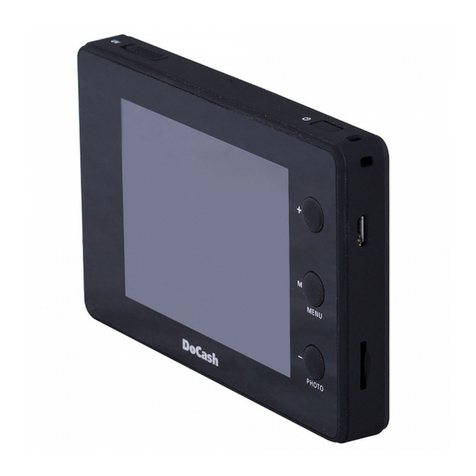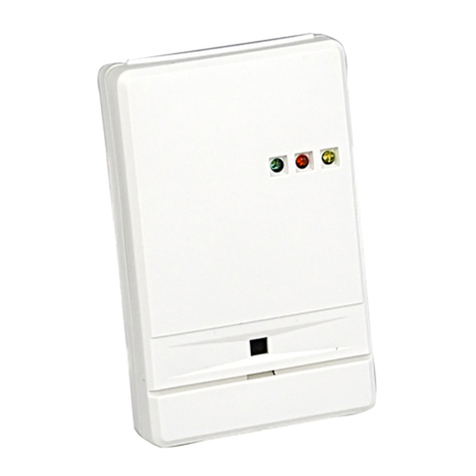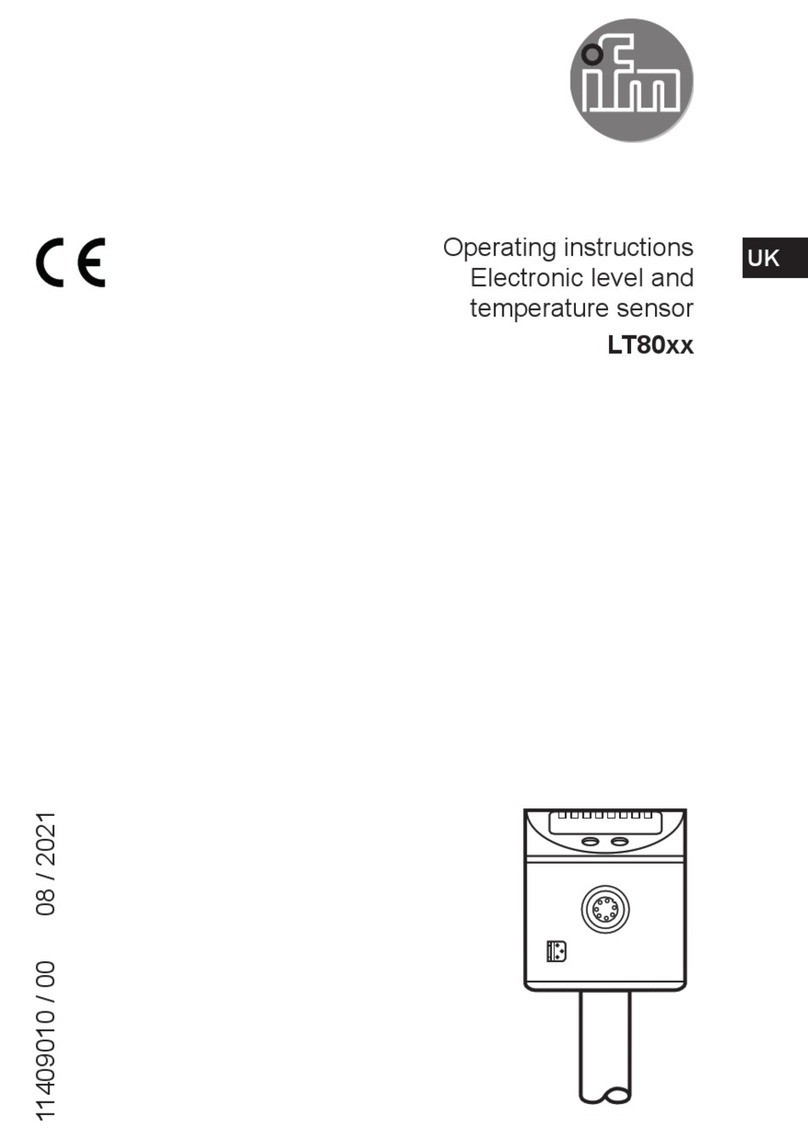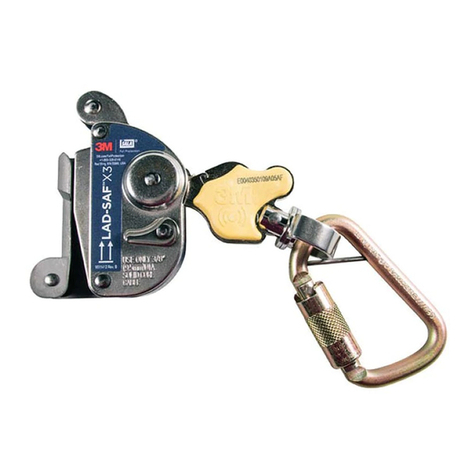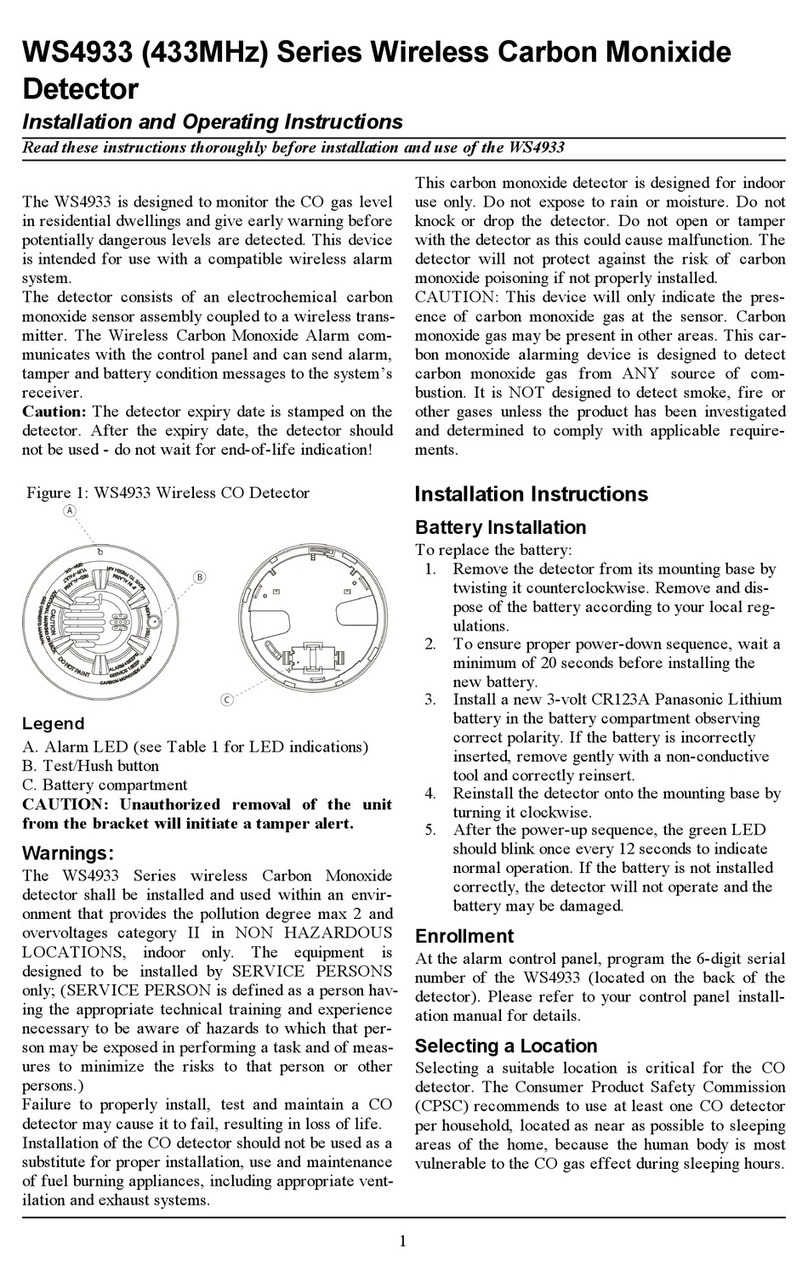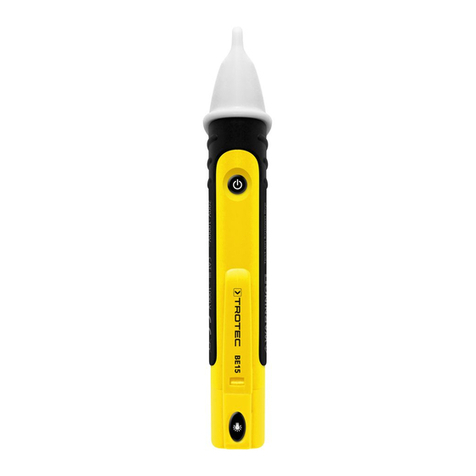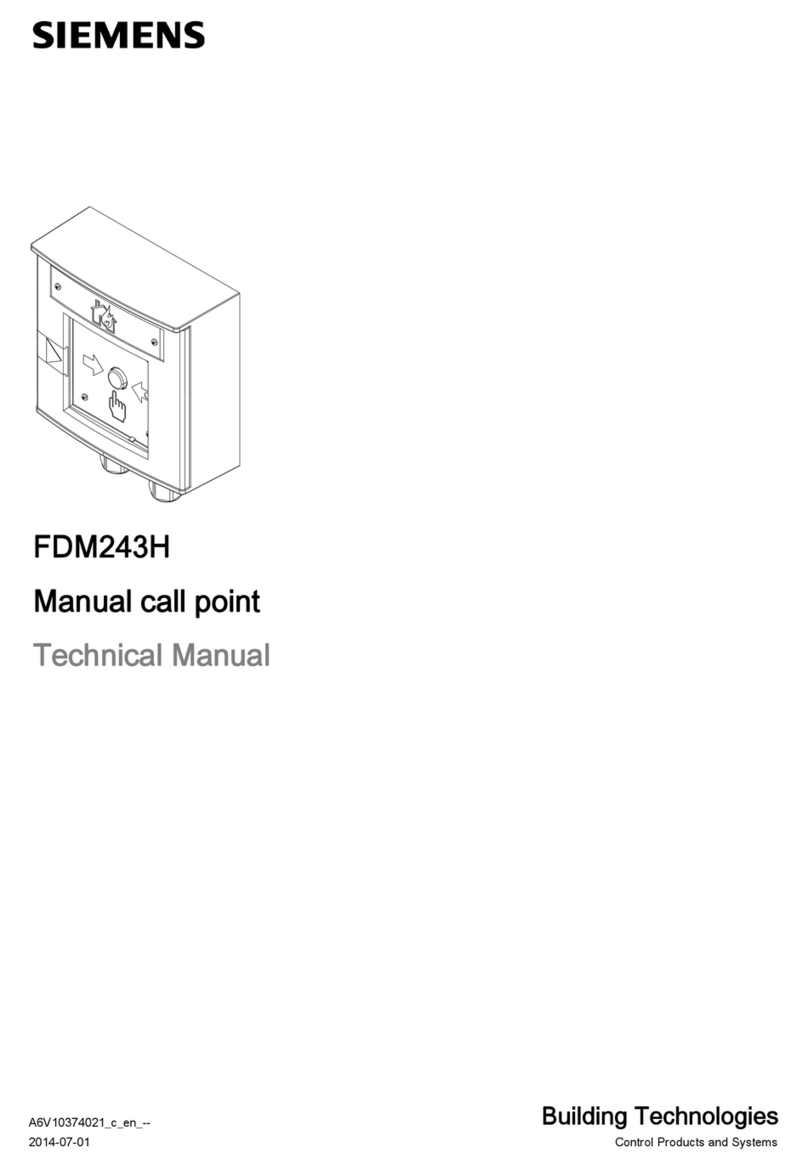Southwest Microwave 310B User manual

Southwest Microwave, Inc.
Security Systems Division
TECHNICAL MANUAL
FOR
MODEL 310B
OUTDOOR MICROWAVE LINK

2
TABLE OF CONTENTS
Introduction.......................................................................................................................................... 3
Description........................................................................................................................................... 3
Optional Equipment ............................................................................................................................. 7
Specifications....................................................................................................................................... 8
Installation Instructions...................................................................................................................... 10
Alignment and Testing....................................................................................................................... 16
Warranty and Equipment Return Information.................................................................................... 18
Note: This manual applies to installation and set-up of Models 310B and 310B-33259.
Copyright Southwest Microwave, Inc. December 2010 –310B™ Printed in USA

3
INTRODUCTION__________________________________________________________
Model 310B Microwave Intrusion Link utilizes state-of-the-art technology to provide superior detection
capability with simple installation and alignment. The Transmitter is powered by a Gunn Diode oscillator which
requires only 150mA (at 12VDC), permitting several links to be powered from a common power supply located
at the control panel or other convenient location.
Model 310B is equipped with universal mounting brackets for mounting to a variety of posts or wall structures.
Built-in alignment voltage test points, compatible with standard VOM, together with four LED indicators,
permit quick alignment and site troubleshooting without special test equipment.
DESCRIPTION_____________________________________________________________
Each model 310B consists of one Model 310BT Transmitter and one Model 310BR Receiver, each with
universal mounting bracket. The transmitter radiates amplitude modulated K-band energy that travels to the
receiver where it is detected. The received energy is amplified and processed so that is causes an alarm relay to
be energized. When an intruder approaches the beam, received energy is changed causing the relay to be de-
energized, and an alarm occurs. Operation of Model 310B is illustrated in Figure 1.
Figure 1 –Operation of T/R Link
A single Model 310B may cover a distance up to 1,500 feet (475m). The Receiver is equipped with automatic
gain control (AGC), which automatically adjusts receiver for the distance to be covered.
Typical maximum width protection pattern of Model 310B is shown in Figure 2 for mounting height of 2.5 feet
(.76m) above smooth earth.
1500 FT. (437m) ANTENNA PATTERN
40 FT (12m)
Figure 2 –Typical Maximum Horizontal Pattern

4
Maximum width occurs when Transmitter-Receiver distance is maximum and Receiver “Sensitivity” control is
set to maximum.
Figure 3 illustrates how pattern width varies with Transmitter-Receiver distance and sensitivity setting. Actual
patterns will vary somewhat with site topography and surface condition. Generally, lower mounting height or
rougher surface will increase pattern width.
For example, if the total link distance is 750 feet (229m) and the sensitivity adjustment set to mid-point. Figure
3 indicates the detection pattern width to be twelve feet. (3.6m).
NOMINAL BEAM WIDTH - FEET
40
(12m)
30
(9m)
20
(6m)
10
(3m)
0250
(75m) 500
(152m) 750
(229m) 1000
(305m) 1250
(381m) 1500
(457m)
SENSITIVITY
MAX.
TOTAL LINK DISTANCE - FEET
0
MIN.
Figure 3 –Pattern Width vs Link Distance and Sensitivity
Vertical protection pattern will also depend upon Transmitter-Receiver distance, mounting height and
“Sensitivity” setting. Protection pattern above Transmitter-Receiver centerline will be approximately half of the
horizontal pattern shown above.
Protection pattern below centerline will tend to fill area between beam centerline and ground except for a “dead
zone” immediately in front of and below Transmitter and Receiver. This zone is best protected by overlapping
links at ends and corners as shown in Figures 4A, B, and C.
30 FEET
(9.2m)
DEAD
ZONE
SIDE - FRONT
VIEW
Figure 4A –Side Front View –Dead Zone

5
30 FEET
(9.2m)
TOP VIEW
CORNER OVERLAP
Figure 4B –Top View –Corner Overlap
OFFSET
18" - 20"
(46 - 51cm)
INTERMEDIATE OVERLAP
BEAM
CENTERLINE
TOP VIEW
60 FEET (18.3m)
Figure 4C –Top View –Intermediate Overlap
Figure 5 shows the amount of overlap required to protect against hands and knees crawl, as a function of
“Sensitivity” setting. For maximum security applications where detection of prone “commando style” crawl
is required, the intermediate overlap should be 60 feet (18.3m) minimum with parallel beam centerline offset
of 18 inches (46cm) maximum. The corner overlaps should be 30 feet (9.2m) minimum. Terrain flatness
should be no more than plus three inches or minus three inches deviation from a plane drawn between the
transmitter and receiver. The zone length (Transmitter to Receiver) should not exceed 600 feet (183m).
DEAD ZONE - FEET
0SENSITIVITY
MIN.
DEAD ZONE
6 (1.8m)
12 (3.6m)
18 (5.5m)
24 (7.3m)
30 (9.2m)
36 (11m)
MAX.
Figure 5 –“Sensitivity” vs Dead Zone

6
TRANSMITTER____________________________________________________________
Model 310B Transmitter consists of two major subassemblies –RF Assembly and Transmitter Circuit Board. A
block diagram is shown in Figure 6.
MODULATOR
REGULATOR ANTENNA
GUNN
OSCILLATOR
MODULATED
K-BAND ENERGY
POWER
"ON" LED
12
VDC +
TEST
A B C D MODULATION
CHANNEL
Figure 6 –Model 310BT Transmitter
The RF assembly consists of a Gunn oscillator, which generates K-band microwave energy and the parabolic
antenna system. The Transmitter circuit board contains voltage regulator and modulator circuit to drive the
microwave oscillator. Modulation frequency is selected from one of four channels (A, B, C, D) on the
Transmitter Circuit Board.
A “Test” terminal is provided on the Transmitter Circuit Board. Application of 5.0 to 14.0 VDC (from Power
Supply) will cause Transmitter to turn off, generating a test alarm at receiver. A red “ON” LED on Transmitter
Circuit Board indicates that power is on.
RECEIVER________________________________________________________________
Model 310BR Receiver consists of three major subassemblies –RF Assembly, Receiver Circuit Board and
Power Supply Board. A block diagram of Model 310BR Receiver is shown in Figure 7. The RF Assembly
consists of a parabolic antenna (identical to antenna of Transmitter) and a Schottky diode detector. The detector
converts modulated K-band energy from Transmitter into an audio frequency signal for processing by
Demodulator Circuit Board.
The received audio signal is amplified by an automatic gain control (AGC) preamplifier enabling the
preamplifier output to be held to a constant level regardless of Transmitter Receiver distance (distance must be
within maximum distance of Figure 2). Preamplifier output is applied to a phase locked loop (PLL) detector that
operates as a narrow band-pass filter at one of the modulation frequencies. Receiver channel is selected by
means of PCB jumper to match modulation frequency of Transmitter while rejecting spurious signals and other
Transmitters.
PLL detector output is a voltage level that is held constant under normal conditions by the slow-acting AGC
loop. Rapidly changing signal strength caused by a target moving into the microwave beam is not affected by
AGC loop and causes an AC signal to appear at PLL detector output. Signal is amplified, filtered and compared
with upper and lower alarm threshold voltages.
Whenever signal exceeds either threshold voltage, an alarm is generated. Gain of signal amplifier may be
adjusted with “Sensitivity” potentiometer on circuit board to modify protection patterns per Figures 3. Signal
bandwidth, affecting Model 310B’s response to fast moving targets, may be set “Fast” or “Slow” with PCB
Jumper.

7
The alarm relay circuit is factory adjusted to automatically reset after approximately two seconds, but hold-in
time may be adjusted between 0.5 and 60 seconds by potentiometer on Power Supply Board. Moving PCB
jumper from “Normal” to “Latch” may defeat automatic reset. In this condition an alarm will cause relay to
latch in the alarm position until reset with 5-15 volt pulse on reset terminal.
Model 310BR Receiver is equipped with various alignment and troubleshooting features. Alignment voltage
test point provides a DC voltage proportional to received signal strength that may be measured with an ordinary
VOM.
A red “Alarm” LED light whenever an intrusion occurs. A red “Wrong Channel” LED lights whenever
Transmitter and Receiver are set to different modulation channels. A red “Jamming” LED lights whenever
Receiver is illuminated with a second Transmitter set to the same modulation channel. “Jamming” indication
causes an alarm to be initiated.
AGC PREAMP
ALIGN
MODULATED ENERGY
FROM K-BAND TRANSMITTER
12
VDC +
ERROR
AMPLIFIER
NORMAL / SLOW
ALIGN / LATCH
RELAY
RESET
ALARM
CONTACTS
WRONG
CHANNEL
JAMMIMG ALARM
ALARM CIRCUIT
FAST SLOW
SIGNAL AMPLIFIER
SENSITIVITY
A B C D CHANNEL SELECTION
BY PCB JUMPER
SCHOTTKY
DETECTOR
ANTENNA
HOLD-IN
PLL
DETECTOR
REGULATOR NC
NO
COM
-
Figure 7 –Model 310BR Receiver
OPTIONAL EQUIPMENT___________________________________________________
Model PS40 Power Supply operates from 110 VAC, 50-60Hz, 0.5A and furnishes 13.7 VDC at up to 1.6A.
Model PS41 Power Supply operates from 220 VAC, 50-60Hz, 0.25A. Power supplies contain automatic
switchover and battery charging circuitry for optional standby batteries of up to 25AH. Power supplies are fused
on both input and output for maximum protection.
Model PS13 Power Supply operates from 85-246VAC, 47-63Hz and furnishes 13.6 VDC at up to 2.8A. Power
supplies contain automatic switchover and battery charging circuitry for optional standby batteries of up to
25AH. Temperature rated from 14° to 122° F (-10° to 50° C). UL, ETS, EMC, CE, RoHS compliant.

8
Rechargeable standby batteries are available in several sizes.
Model BA30 –12.6V 6.5AH jelly acid battery
Model RM83 Performance Test Set provides indication of (1) input power supply voltage, (2) alignment, (3)
sensitivity and (4) audio/visual alarm indication. Designed for use with Model 310B. It is recommended for
setup and maintenance testing.
Model MB65 Corrosion Resistant Mounting Bracket provides means of locking the angular direction setting of
Model 310B Transmitter or Receiver. Model MB65 mounts to 4” (10cm) O.D. post.
SPECIFICATIONS_________________________________________________________
1.0 Detection Capability
1.1 Range: 100 feet (30.5m) to 1500 feet (457m).
1.2 Beam Diameter: 2 feet (.6m) to 40 feet (12.2m) depending upon link distance and “Sensitivity”
setting per Figure 3.
1.3 Target: 77 pound (35kg) human –walking, running, hands and knees crawling or jumping. Prone
crawling or rolling 77 pound (35kg) human or simulated with a 12-inch (30cm) diameter metal
sphere, detected at maximum range of 600 feet (183m).
1.4 Minimum Target Velocity: 0.1ft./sec. (3cm/sec.)
1.5 Maximum Target Velocity: 10ft./sec. (3m/sec.) slow setting, 50 ft./sec. (15m./sec.) fast setting.
2.0 Reliability
2.1 Equipment False Alarm Rate: 1/year/unit based upon signal-to-noise ratio at maximum sensitivity
setting.
2.2 Probability of Detection: 0.99% minimum on 77 pound (35kg) human upright or on hands and
knees.
2.3 Self Supervision (Alarm on Failure): Inherent in design (fully self-supervised).
2.4 Automatic Gain Control: Receiver sensitivity automatically adjusts to slow changes in
environment. AGC range 54dB.
2.5 Cross Modulation: When installed in accordance with following installation instructions cross
modulation (interference) from adjacent links will be 25dB below primary signal.
3.0 Transmittal Signal
3.1 Radiated Power: 4 milliwatts peak, 2 milliwatts average, square wave modulated.
3.2 Carrier Frequency: K-band (USA 24.125 GHz).
3.3 Modulation Frequencies: Four field-selectable modulation frequencies.
3.4 Above specifications for USA are in accordance with F.C.C. regulations.

9
4.0 Power Requirement
4.1 Voltage: 11.0 to 14.0VDC
4.2 Current: 150mA Transmitter, 20mA Receiver under normal ambient operating conditions.
4.3 Transmitter fused for 0.5 amp and Receiver each fused for 0.25 amps.
5.0 Alarm Indication
5.1 Alarm Relay Contacts: Primary alarm indications provided by two normally open contacts, two
normally closed contacts and two common terminals (Form C), contact rating 2 amps at 28VDC.
5.2 Walk Test LED: Secondary alarm indication provided by red LED on Receiver Power Supply
Board.
5.3 Jamming LED: Illumination of Receiver by second Transmitter operating on same channel lights
red jamming LED and may initiate alarm condition.
5.4 Tamper Switch, Transmitter and Receiver: Form C contacts rated 2.0 Amp at 28 VDC.
6.0 Alignment and Test Aids
6.1 Alignment Voltage: Available at Receiver Test Point. Positive voltage, suitable for 100,000
ohms/volt VOM, increases with receiver signal strength. Range 0.5-5.0 VDC.
6.2 Align Mode: PCB jumper on Receiver Power Supply Board. “Alignment Mode” provides faster
AGC action for alignment and constant alarm condition to prevent leaving link in Alignment Mode.
6.3 Wrong Channel –LED: Red LED on Receiver Power Supply Board lights when Transmitter and
Receiver set to different channels.
6.4 Transmitter “ON” LED: Red LED on Transmitter Circuit Board indicates that power is on.
6.5 RM82/RM83 Performance Test Set can be used to aid in aligning and testing. RM82/RM83 is
connected to rear of 310BR Receiver by a six (6) pin MS connector. Pin voltages are:
PIN VOLTAGES FUNCTIONS
A 11.0-14VDC Input Power
B 8.0VDC + 0.5V Internal Regulated Power
C 0.5 Minimum Alignment (TPI)
D 0 Chassis Ground
E 3-4VDC (Typical) Signal Voltage (Intrusion)
F 0.1VDC (Normal) Alarm Status
10-12VDC (Alarm)
7.0 Weight, Transmitter, or Receiver: 4.5 pounds (2kg).
8.0 Operating Environment
8.1 Temperature: -40° F to +150° F (-40° C to +66° C)
8.2 Relative Humidity: 0 to 100%.

10
9.0 Dimensions (Transmitter or Receiver)
3.5 in.
(8.9cm)
20oMAX TILT
ANY DIRECTION
Mounting Holes
4.5 in (11.4cm)
2.3 in (5.9cm)
6.0 in.
(15.2cm)
10.6 in.
(27cm)
Dia.
Figure 8 –Model 310B Transmitter or Receiver
INSTALLATION INSTRUCTIONS___________________________________________
A. Location of Model 310B
1. Required Area. Model 310B must be located in an area which is free of obstructions and moving
objects such as chain link fences, trees, bushes and large areas of water. See Figure 9. Large moving
objects within the protection pattern will be indistinguishable from an intruder and will cause nuisance
alarms.
DO DON’T
Figure 9
The clear area required for a Model 310B installation depends upon the distance to be covered by the
link. Protection patterns for various conditions are given in Figures 3. In each installation the clear area
must be at least as large as the protection pattern.
2. Terrain. Since the operation of Link requires transmission of energy from Transmitter to Receiver, it
is important to maintain a clear line of sight between the units. Therefore, the ground must be flat
across the protected area. Any bumps, hills or ditches in the area will shadow the beam and may
provide crawl space for an intruder. Bumps or hills must be leveled, and ditches filled so that the area
is flat to within six (6) inches (15cm). See Figure 10.

11
DO DON’T
Figure 10
The protected area can be any stable, reasonably smooth material such as concrete, asphalt, tilled
earth or gravel. If there is grass or vegetation in the protected are it must be kept cut to a maximum of
three (3) inches (8cm) in height. Snow accumulation should not exceed three (3) inches (8cm) in
height. A Model 310B Link should not be operated over open water.
3. Physical Protection. Install the Transmitter and Receiver in locations that provide protection from
accidental damage as well as from tampering. Simple devices such as bumper posts or parking guards
may be used to protect equipment from damage from vehicles. See Figure 11.
DO DON’T
Figure 11
4. Best Security. Choose the location that will provide best security, yet be free from false alarms.
Always locate Model 310B inside a controlled access area to prevent unwanted alarms due to random
foot traffic, vehicles, or large animals. Typically, units should be mounted two and one-half to three
feet (0.75-1.0m) above ground level, and far enough inside fence to provide a clear area of protection.
See Figures 12 & 13.
For maximum security it is necessary to overlap the ends of links so that the dead spot below and
immediately in front of the adjoining link is protected. This type of location gives maximum possible
security. A 60-foot (18m) overlap is recommended at intermediate points, and a 30-foot (9.2m)
overlap is recommended at corners. If site demands shorter overlap, increased sensitivity will reduce
dead zone, per Figure 5, but will also widen beam, per Figure 3.The offset of overlapping links in line
should be approximately 18 inches (46cm); this distance should be measured from center of each unit
(See Figure 4C). Additional protection may be added at critical points by installing SOUTHWEST
MICROWAVE, INC. Model 380 or 385 Monostatic Sensors, Model 415 Passive Infrared Sensor,
Model MS15 or MS16 Dual Tech Sensors or stacked links.

12
DO DON’T
Figure 12
RECEIVER
RECEIVERRECEIVER
TRANSMITTER
TRANSMITTER
TRANSMITTER RECEIVER
TRANSMITTER
Figure 13
Note form Figure 13 that at each point of overlap, either two Transmitters or two Receivers should be
installed. This arrangement prevents an adjacent Transmitter and Receiver from establishing an
unwanted link across the short overlap distance. If there is an odd number of links in an installation, a
transmitter and receiver will need to be overlapped. This should be done in a corner as shown in
Figure 13.
B. Power Supply Wiring
Model 310B requires only 150mA at 11.0-14VDC for each Transmitter and 20mA for each Receiver.
Therefore, sufficient power with battery standby may already be available at the site from other sensor
power supplies or from the control panel itself. Any regulated “12VDC” Supply will be adequate so long as
noise and transients do not exceed 50mV and attention is paid to voltage drop in connecting wires so that
voltage AT EACH TRANSMITTER OR RECEIVER remains between 11.0 and 14VDC. Voltage drop
versus wire distances are given in Table 1.
SOUTHWEST MICROWAVE offers two optional power supply combinations. Model PS13, 2.8 Amp
Power Supply with Model BA30 7AH Battery will power up to ten Model 310B T/R Links. Model PS40,
1.6 Amp Power Supply with Model BA30 7AH Battery will power up to five Model 310B T/R Links (with
proper wiring per Figure 15). Supplies may be mounted either indoors or outdoors in a rainproof enclosure
such as SOUTHWEST MICROWAVE Model BX15, BX20 or BX35.
6 to 10 Feet (1.9 to 3.1m)
2 to 3 Feet
(.61 to 1.0m)

13
Table 1 –Voltage Drop vs Wire Gauges
C Mounting Model 310B T/R Link
1. Prepare a rigid mounting surface for the Model 310B Transmitter and Receiver. Do not mount units
on a cyclone fence or any vibrating surface. A recommended mounting post is a 3 ½ inch (9cm)
galvanized pipe (outside diameter 4 inches, 10cm), sunk into the ground in a concrete base, and
protruding above ground level to a height of 4 feet (1.2m). Mount the Transmitter and Receiver 2 ½
to 3 feet (0.75 to 1.0m) above ground level and allow for height adjustment of at least plus or minus 6
inches (15cm). Height adjustment may be required during final alignment to achieve optimum
protection pattern. See Figure 14. An 18-inch (46cm) ½ inch flex conduit is recommended between
conduit fitting of T/R and rigid conduit.
Tamper, Alarm and Power Lines
24" Deep x
18" to 24"
Square
Typical
Grounding
Rod
per Local
Electrical
Code
Ground Lug
48"
1/2" x 18"
Flexible
Conduit 36"
4" O.D.
Galvanized
Pipe
Cap
Gnd. Lug &
Wire
#6 AWG
GROUND BUS
Concrete
Nominal
Figure 14
WIRE GAUGE
# 16 AWG (1.29mm dia.)
# 18 AWG (1.05mm dia.)
# 20 AWG (0.82mm dia.)
# 22 AWG (0.66mm dia.)
# 24 AWG (0.54mm dia.)
VOLTAGE DROP PER
500 FT. (150m)
TRANSMITTER
0.6V
1.0V
1.5V
2.5V
4.0V
VOLTAGE DROP PER
500 FT. (150m)
RECEIVER
.12V
.2V
.3V
.5V
.8V

14
2. Remove the Model 310B T/R Link from the shipping containers. Separate the swivel assembly from
the mounting plate by turning the large nuts counter-clockwise. Large nuts require 1 ¼ inch (32mm)
open-end wrench.
3. Secure the mounting bracket to the post with U-bolt or to other mounting surface with appropriate
screws or fasteners.
4. Secure the swivel assembly to Model 310B Transmitter and Receiver and attach to mounting bracket.
5. Rotate the Model 310B Transmitter and Receiver so that the conduit fittings are pointed straight
down.
6. Tighten the large nuts on the swivel assembly to hold the units in place.
D. Connecting Model 310BT Transmitter
Caution: DO NOT APPLY POWER UNTIL ALL WIRE CONNECTORS HAVE BEEN MADE. SEE
FOLLOWING INSTRUCTIONS.
1. Remove the radome of Model 310B Transmitter by removing the six-radome screws.
2. Insert power wires and optional tamper circuit wires through conduit fitting. Leave enough slack in
wires so that Transmitter may be tilted after radome is replaced.
3. Make connections to the terminal strip according to labeled terminal functions (See Figure 15.)
4. Attach power wires to terminal identified as +12VDC (Positive) and GND (Negative). OBSERVE
POLARITY.
NOTE: SHIELDED WIRE
RECOMMENDED
310BT TRANSMITTER 310BR RECEIVER
NOTE: After wiring is complete, it is recommended that entry conduit be filled
(sealed) with non-corrosive sealant such as Dow Corning #738 RTV. This will
prevent moist air in the conduit system from entering the transmitter or
receiver.
12VDC
SUPPLY
+ -
TO TAMPER
CIRCUIT TEST
TO POWER
SUPPLY
TO TAMPER
CIRCUIT TO ALARM
CIRCUIT
RESET
TO POWER
SUPPLY
TAMPER
SWITCH
COM.
INPUT
12VDC
+
T
-S
E
TN.O. N.C. TAMPER
SWITCH
INPUT
12VDC
+SET
-REN.O. COM. N.O.
N.C. ALARM
RELAY 1
COM. ALARM
RELAY
N.C. N.O.
2
COM. N.C.
Figure 15 –Wiring Diagram

15
5. For protection against unauthorized openings or tampering, a tamper switch with a separate set of
contacts is provided. Form C tamper contacts are available at “Tamper Switch” terminal.
6. Connect remote test wire if used, to terminal 3.
NOTE: After wiring is complete, it is recommended that entry conduit be filled (sealed) with non-
corrosive sealant such as Dow-Corning #738 RTV. This will prevent moist air in the conduit system
from entering Model 310B Transmitter or Receiver.
E. Connecting Model 310BR Receiver
1. Remove radome of Model 310BR Receiver by removing the six-radome screws.
2. Insert power wires and alarm circuit wires through conduit fitting. Leave enough slack in wires so
that Receiver may be tilted after radome is replaced.
3. Make connections to the terminal strip according to labeled terminal functions. (See Figure 15.)
4. Attach power wires to terminal identified as +12VDC (Positive) and GND (Negative). OBSERVE
POLARITY.
5. Attach alarm circuit wires as follows:
CLOSED CIRCUIT ALARM contacts (open on alarm) available at “Alarm Relay” COM and NC
terminals.
OPEN CIRCUIT ALARM contacts (close on alarm) available at “Alarm Relay” COM and NO
terminals.
TAMPER contacts available at Tamper Switch terminals.
6. Connect reset wire if used, to terminal 3.
F. Modulation Frequency Selection
The Model 310BT Transmitter features four (4) field selectable modulation frequencies. It is advantageous
to use different modulation frequencies on links operating within close proximity. Different modulation
frequencies reduce the possibility of cross-link modulation or mutual interference.
1. Select modulation channel different from the modulation of other links operating in the immediate
area.
2. Attach PCB jumper wire to appropriate terminal to select desired channel. (See Figure 17.)
The Model 310BR Receiver also features four (4) field selectable frequencies. The Receiver and
Transmitter MUST be operated on the same frequency or an alarm condition will result.
3. Determine the modulation frequency of the Transmitter illuminating the Link Receiver.
4. Attach PCB jumper wire to appropriate terminal for the desired Receiver channel. (See Figure 16.)

16
MODULATION
FREQUENCY
ALIGN/LATCH
TAMPER
SWITCH
INPUT 12
VDC
R
E
S
E
T
ALARM
RELAY 1ALARM
RELAY 2
NORMAL
RELAY HOLD
C
B
D
A
SENSITIVITY
ALIGN
TP1
E1
WRONG CHANNEL
JAM
ALARM
Figure 16 –Model 310BR Receiver
POWER
MODULATION
FREQUENCY
TAMPER
SWITCH
INPUT 12
VDC
T
E
S
T
AC
BD
Figure 17 –Model 310BT Transmitter
ALIGNMENT AND TESTING________________________________________________
An MS type connector has been added to the rear side of the Receiver baseplate. This connector, when used in
conjunction with SOUTHWEST MICROWAVE Model RM82 Link Performance Test Set, will facilitate field
alignment and testing of Model 310B Microwave Links without removal of radome. The following outline will
assist the installer in alignment and testing of the Model 310B Microwave Intrusion Link using a VOM (volt-
ohm-meter) with an input impedance of 100,000 ohms/volt or greater.
1. With radomes removed, apply power to the Transmitter and Receiver.
2. Be sure the identical modulation frequency is being used on the Transmitter and Receiver of the Link to be
aligned.
3. Check for Transmitter operation by monitoring the Transmitter “ON” LED on the Transmitter Circuit
Board. (See Figure 17.)

17
4. Visually aim the Transmitter and Receiver for “bore-sight” alignment.
5. Move the Align/Latch –Normal jumper to Latch position. (See Figure 16.)
6. On Receiver, connect VOM to TP1 (Positive Meter Lead), and E1 GND (Negative Meter Lead), with meter
range set to 3-5VDC. (See Figure 16.)
7. Swivel Receiver up and down, side to side, to obtain maximum meter reading. Tighten locking nut on
mounting bracket to secure sensor in this position.
8. Raise or lower mounting height of Receiver and/or Transmitter as required to obtain maximum meter
reading.
9. Swivel Transmitter up and down, side to side, to obtain maximum meter reading. Tighten locking nut on
mounting bracket to secure sensor in this position. The minimum alignment and voltage for the Model
310B is 0.5VDC. Although this is the minimum voltage, proper alignment and mounting height will
typically give a greater indication on the meter.
10. Disconnect VOM and move Align/Latch-Normal jumper to Normal position.
11. Walk test the Link to determine width of pattern, while monitoring alarm indication by means of red
“Alarm” LED.
12. Adjust pattern width by turning “SENS” potentiometer clockwise to increase and counterclockwise to
decrease, until desired width is obtained. (See Figure 3.)
13. Replace radome using all six screws.
HIGH SECURITY TEST FUNCTION_________________________________________
In high security areas, it is desirable to test and reset a link from a remote point. This feature has been
incorporated into the Model 310B.
1. To test the Transmitter, a voltage of 5 to 14VDC must be applied to terminal “TEST” on the Model 310BT.
(See Figures 15 and 17.)
2. Testing of the Transmitter may be accomplished by momentarily switching “ON” the 12VDC from the
Power Supply to the “TEST” terminal. Note the “TEST” terminal requires +5 to 14VDC.
3. When the “TEST” is actuated, the Receiver will alarm. A higher degree of security can be obtained by
utilizing the “Latch” function of the Model 310BR Receiver.
4. Connect the “Align/Latch – Normal” PCB jumper to “Align/Latch” position. This will cause the Receiver
to latch into the alarm state when either the “TEST” function is used at the Transmitter or an intrusion of
the link has occurred.
5. To reset the link to the normal non-alarm condition, 5-15 VDC must be applied to terminal “Reset” on the
Model 310BR. (See Figures 15 and 16.)
By utilizing both the “Test” and “Reset” functions, the link can be tested and secured from a remote point.

18
PREVENTIVE MAINTENANCE______________________________________________
Model 310B requires no calibration other than alignment and sensitivity adjustment during installation. To
maintain a trouble free system the following is recommended.
1. Wax the radomes every 3 to 6 months. (At maximum security installations, where detection of prone
crawling targets is required, wax once a month.)
2. Keep the isolation area clean and free of tall grass, weeds, debris, and obstructions.
3. Upon initial installation, establish a zone data chart. Record input supply voltage, zone distance,
transmitter/receiver mounting height, alignment voltage, modulation channel, sensitivity setting, and
battery voltages.
4. If standby batteries are used, they should be functionally tested every three months.
5. A site inspection should be performed every six months. The inspection should include: verifying data from
Step 3, checking for physical damage (cracks, leaks, corrosion, etc.) checking for isolation zone changes
(washouts, materials placement, vegetation growth, loose fence fabric, etc.)
6. For troubleshooting information, please contact the factory about Model 310B Service Manual.
LIMITED WARRANTY_____________________________________________________
SOUTHWEST MICROWAVE, INC. warrants each of its products to be free from defects in materials and
workmanship. The limit of liability under this warranty is to repair or replace any products or part thereof
which shall within one year after delivery to the original user be returned, shipping costs prepaid and insured, to
SOUTHWEST MICROWAVE, INC. at its plant in Tempe, Arizona, or authorized Warranty Service Company,
and which shall have been found to be defective upon examination by SOUTHWEST MICROWAVE, INC. or
authorized Warranty Service Company.
This warranty shall be limited to the repair or replacement of SOUTHWEST MICROWAVE, INC. products
and shall not extend to any incidental or consequential damages there from. Disassembly of any product by
anyone other than an authorized representative of SOUTHWEST MICROWAVE, INC. voids the obligations of
SOUTHWEST MICROWAVE, INC. to repair or replace any products so disassembled.
Excluded from this warranty are fuses and batteries except to the extent that the original manufacturer warrants
such parts, and such warranty is marked on the product. Claim under warranty for fuses and batteries should be
made by the purchaser directly to the manufacturer.
Warranty returns must first be authorized by SOUTHWEST MICROWAVE, INC. or authorized Warranty
Service Company.
SOUTHWEST MICROWAVE, INC. reserves the right to make changes in design on any of its products
without incurring any obligation to make the same changes on units previously purchased.
This warranty is the extent of the obligations or liabilities assumed by SOUTHWEST MICROWAVE, INC.
With respect to its products and is in lieu of all other warranties, express or implied, including, but not limited
to, any warranty of merchantability or fitness. SOUTHWEST MICROWAVE, INC. shall not be liable for
consequential damages and its liability is expressly limited to the obligations expressed herein. SOUTHWEST
MICROWAVE, INC. Neither assumes nor authorizes any other person to assume for it any other warranty
concerning its products.

19
RETURNING EQUIPMENT UNDER WARRANTY_____________________________
As per the provisions set forth in our Security Products warranty, any person desiring to return equipment to
SOUTHWEST MICROWAVE, INC. for any reason, must first contact SOUTHWEST MICROWAVE, INC.
for authorization of return.
An authorization number will be issued at the time of authorization, and this number will appear on all
correspondence, invoices and credits pertaining to subject equipment.
ALL SOUTHWEST MICROWAVE, INC. sensors and power supplies are provided with a serial number at the
time of manufacture. In order to accurately and efficiently supply replacement parts, perform repair service, or
issue credit on equipment being returned to SOUTHWEST MICROWAVE, INC., it is essential that
SOUTHWEST MICROWAVE, INC. be advised of the serial number of the equipment prior to authorization
for return. This notification may be made by telephone or by mail.
RETURNING EQUIPMENT FOR NON-WARRANTY REPAIR___________________
Return of equipment out of warranty must first be authorized by SOUTHWEST MICROWAVE, INC. at which
time a return authorization number will be issued. The returned equipment must be accompanied by an
evaluation repair purchase order. Returned equipment will be examined and customer advised of cost of repair
or replacement.
REPLACEMENT PARTS____________________________________________________
To order a replacement or module, specify the complete part number and serial number and address the order or
contact us at:
SOUTHWEST MICROWAVE, INC.
9055 South McKemy Street
Tempe, Arizona 85284-2946
TEL: (480) 783-0201
FAX: (480) 783-0401
Infossd@southwestmicrowave.com
www.southwestmicrowave.com
Table of contents
Other Southwest Microwave Security Sensor manuals
Popular Security Sensor manuals by other brands
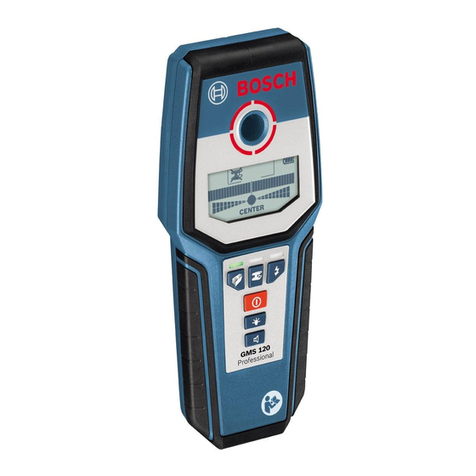
Bosch
Bosch GMS 120 Professional manual
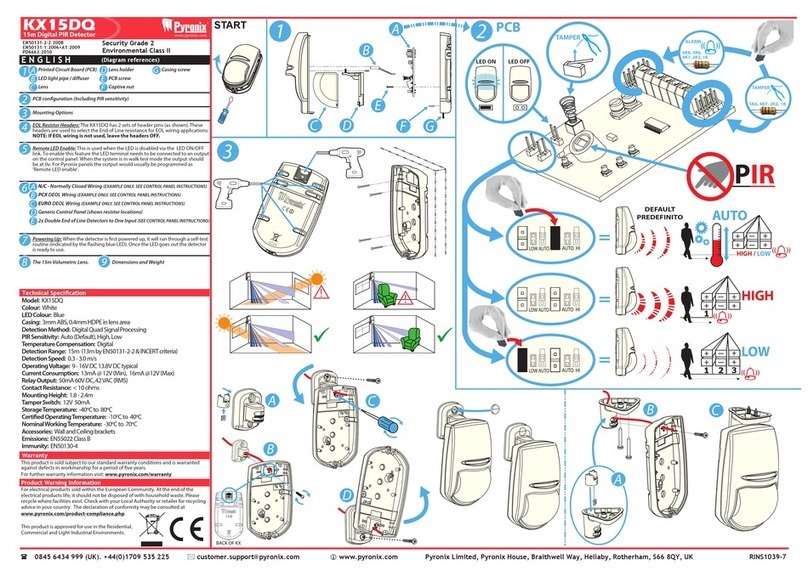
Pyronix
Pyronix KX15DQ quick start guide

Notifier
Notifier GL91AMP Installation and operating manual
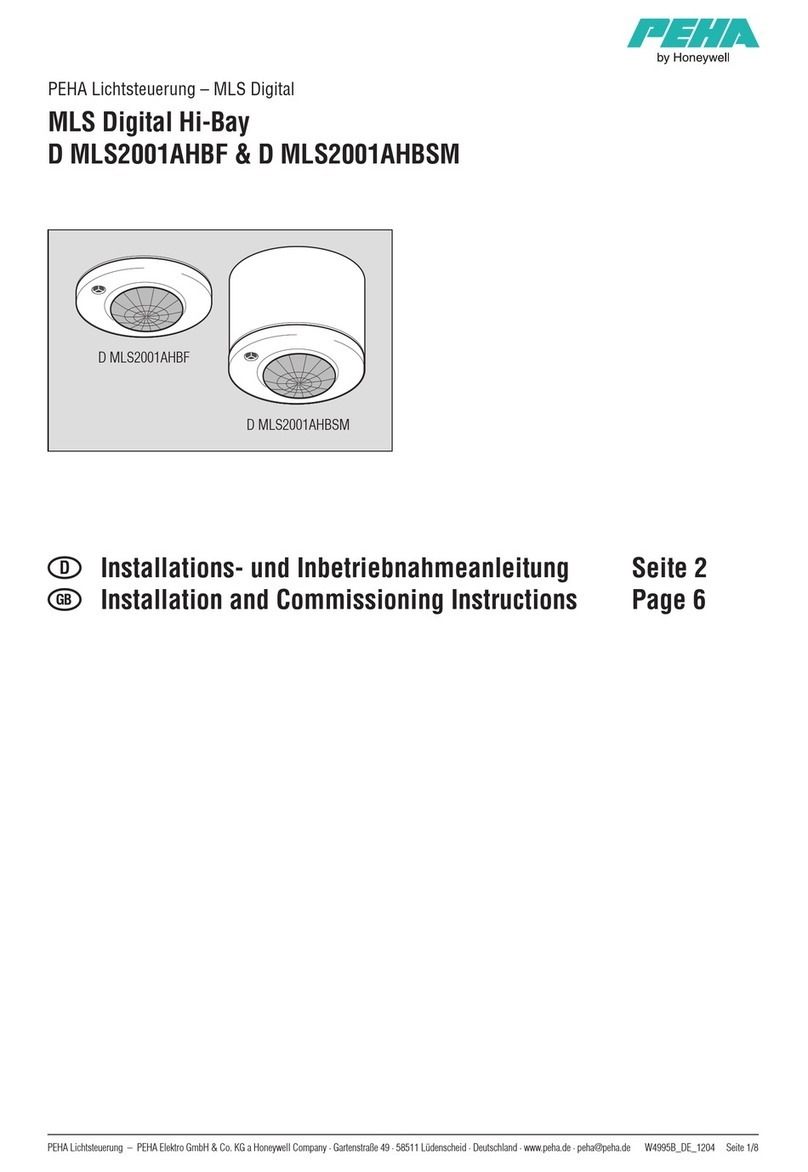
Honeywell
Honeywell PEHA MLS Digital Hi-Bay D MLS2001AHBF Installation and commissioning instructions

Treasure Cove
Treasure Cove Vibra-Tector 730 quick start guide
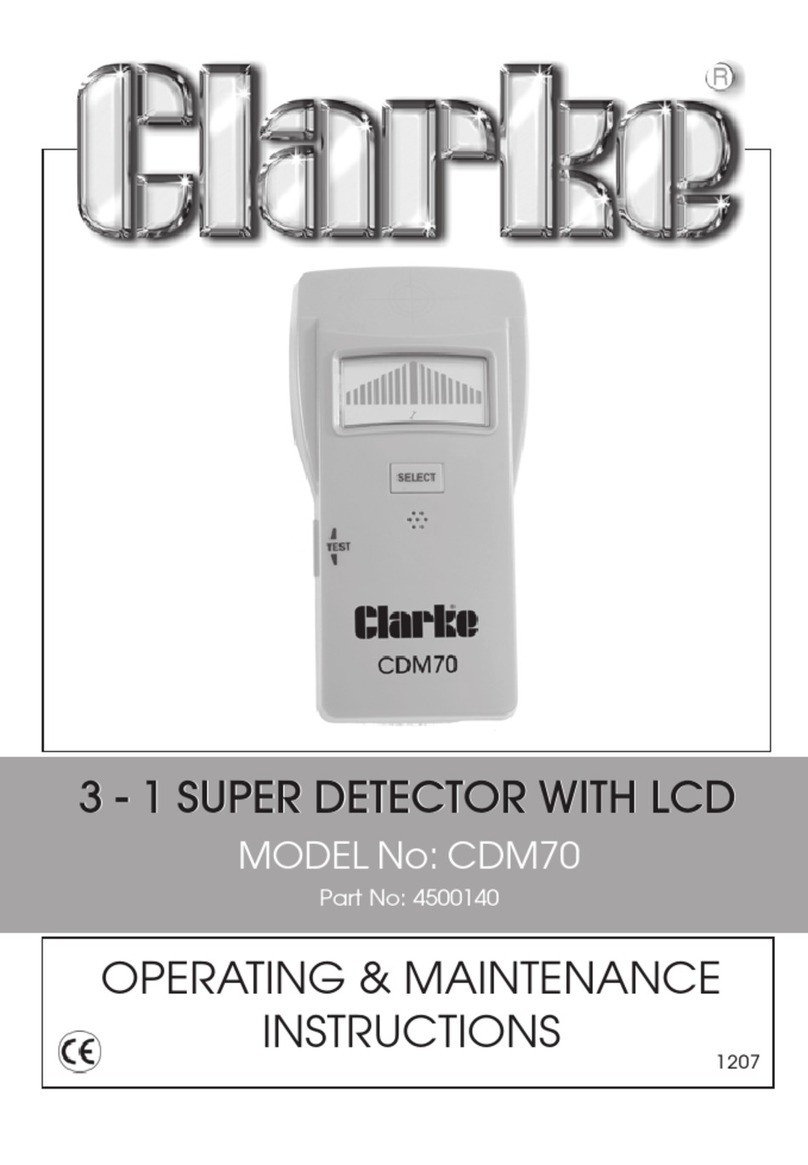
Clarke
Clarke CDM70 Operating & maintenance instructions
